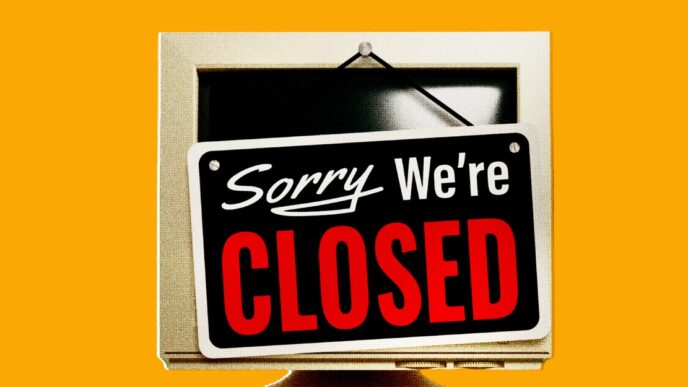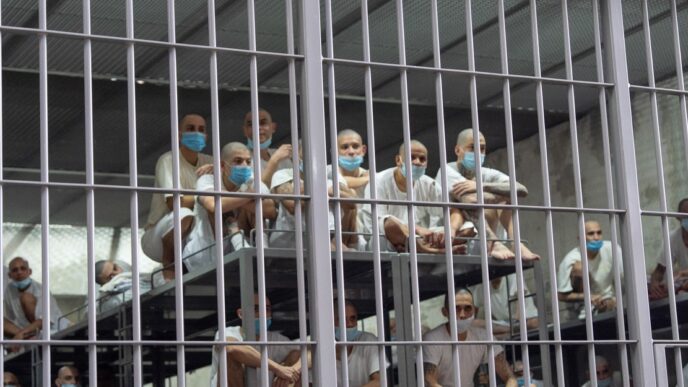I miscarried in three acts.
The first was the bad appointment: the somber technician; the clinical, straightforward news—not enough growth for eight weeks and, worse, no heartbeat. She was so sorry; the doctor would be in touch.
The second act was the D&C, short for “dilation and curettage”: the paperwork, the kind and efficient nurses, the IV and the sterile room—all stainless steel and bright lights, solid stirrups, and tissue-paper gowns—and the scraping from my uterus of what was supposed to have been my baby.
The third act was another D&C: the same as the previous time, but now even less dignified, somehow, because shouldn’t it be enough to miscarry once? There’s extra tissue, they said; sometimes this happens.
I had not ordered the upgraded version, the miscarriage with a side of miscarriage.
The day I learned my pregnancy ended was March 1, 2022, but I remember it mostly as also being the day of President Joe Biden’s State of the Union address. As my husband, Mike, and I left the doctor’s office, the midday sun glinting off my tears, Mike said he felt like he was going to throw up.
We walked through downtown D.C. holding hands for a few blocks. Then I went back to work, and waited for Biden’s speech. While I was waiting, the doctor called, as promised. I grabbed a reporter’s notebook and ducked into an alcove so she could walk me through my options.
You can just wait to miscarry naturally, she said, but she didn’t recommend that option. She explained that it can take days, weeks, even months before your body realizes the baby has stopped growing, and most people have trouble with the waiting.
The next option was to take a pill that starts the process of passing the blood, the cells, the tissue; she could call the prescription in, and I could begin the process at home. Her office would give me medicine to manage the anxiety, medicine to manage the nausea, medicine to manage the pain. I’d call them every few hours, to update them about my progress.
The final option was a D&C, a procedure also used to end pregnancies, though I didn’t understand this at the time. I’d have to wait for an opening in the schedule, she explained, which could take a few days, but then it would be quick and relatively painless; I’d come in, undergo deep sedation, have the tissue scraped from my uterus, and go home the same day.
Her recommendation was the pill—the D&C could occasionally lead to scarring—but the choice was mine. I felt helpless, unsure of what to do other than cry. But I did what I often do when I’m upset, and began oversharing with my friends and family.
Every Wednesday night, I have a standing Zoom with five other women, all friends from college. The tradition started as a one-off whim during the pandemic but is now in its fifth year. Sometimes we skip a week, and rarely do all six of us make it, but almost every Wednesday night at 8:30, some configuration of us meets virtually to gossip and talk about our lives.
Between us, we have been pregnant 24 times and collectively given birth to 14 kids.
This statistic—six women, 24 pregnancies, 14 kids—stops me cold every time it occurs to me, but it shouldn’t. As many as one-quarter of known pregnancies end in miscarriage, according to the National Library of Medicine, and some research suggests that the actual number may be much higher, because some women miscarry without ever knowing they were pregnant. And most of us were in our 30s—if not “geriatric” or of “advanced maternal age,” in OB-GYN parlance—when we got pregnant.
And so, in the unluckiness of others, I was lucky. Because my friends had talked openly about some of their toughest moments, I felt less alone during mine.
I sometimes think of one of these friends, the one who miscarried three times in 2019, as the human embodiment of the what-to-do-when-you’re-miscarrying options that my doctor had talked me through. Except my friend wasn’t any one of those options. She was D, all of the above. And she was a real person, who had grieved each loss.
She explained that the time she had miscarried naturally had been the best by far—finding out the bad news from the cramps and the blood—but because that wasn’t an option for me, she definitely recommended a D&C. She had taken the pill for one of her miscarriages, but she’d ended up hemorrhaging, which meant she’d been rushed to the hospital for what ultimately ended in a D&C anyhow.
I called another friend, a fellow journalist who had done eight rounds of IVF to have a baby on her own after a divorce. She’d also had two miscarriages—including one during the IVF process—and found the clinical precision of a D&C comforting amid all the variables she couldn’t control. “You don’t want to be dealing with that shit at home, alone,” she said.
She was right. I have a low tolerance for pain, and I freak out at the mere mention of vomit. (Perhaps my proudest parenting achievement was when I taught my then-4-year-old to get to the bathroom entirely on her own at the first ominous mention of a middle-of-the-night stomachache). I imagined myself in our upstairs bathroom, passing blood clots the size of golf balls, sweating and staving off dry heaves, and trying to suss out via telehealth if this was all “normal”—just an especially gory outtake from Scream—or if I was on the verge of bleeding out.
I called back and scheduled a D&C.
My grief was surprising, absurdist, nonlinear.
I walked back to my office and that night wrote about Biden’s speech. I remember looking around the newsroom and taking in my Washington Post colleagues, whose biggest concern seemed to be where our editors had ordered pizza from that night, and silently wondering, How do you not know what’s going on inside my body right now? But I also filed 35-odd inches, clean, quickly, on deadline.
By the time I finally arrived at my D&C appointment a few days later (the first available slot), I felt like a beach towel that had been wrung out—sand-raw, but also damp and rumpled. As I filled out the relevant paperwork affirming that, yes, I understood there was a rare risk of life-threatening complications—that would be a real doozy, I mentally noted—I couldn’t help but laugh grimly to myself as I called the nurse over. “You gave me the wrong forms,” I said. “These say I’m here for an abortion; I’m here for a miscarriage.”
A quick half-smile broke her face into a moon of empathy: This procedure is an abortion, she said. You experienced pregnancy loss, but you are technically having an abortion. Of course I understood this intellectually, but in the moment, it all seemed so backward. I didn’t want an abortion. I wanted a baby. But things hadn’t gone the way I wanted them to.
There were other misunderstandings before the actual procedure. I had brought a book with me, Vladimir, by Julia May Jones, marketed as a “razor-sharp” debut novel about on-campus sexual politics and power in the #MeToo era; it had earned critical acclaim. The cover featured, simply, the naked torso of a faceless man slouched rakishly, and one of the nurses made a kind, throwaway joke about my “steamy” reading.
Naked but for a gown, an IV in my arm, I somehow found myself desperately trying to explain to her that this was modern literature, not some erotic paperback, and that I was a journalist, an intellectual, or at least a pseudo-intellectual; that I was someone who had done all the right things; that I’d taken prenatal vitamins and avoided all the vices you’re supposed to avoid; and that this dead pile of cells inside of me was not my fault.
After the procedure, my entire midsection achy with cramps, I just wanted to go home and lie under the covers and weep. But also, I asked Mike, weren’t we near that good soup-dumpling place? And so, on a gray and chilly Tuesday, we slurped rich, porky broth before driving home. “At least now,” I said, “I can’t tell if my stomach hurts from the procedure, or because I ate too many soup dumplings.”
What followed was not what I expected. At first, it was the compassion of others that shattered me. I had emailed my mostly male editors to tell them why I’d be missing a day of work, and they were kind in ways I hadn’t imagined. They called, repeatedly, in the following days, just to check in. My friends, too, sent flowers and cookies and soup—so much soup. I found myself standing in my kitchen late at night, chugging soup, to make sure the matzoh balls and chicken and noodles didn’t go to waste.
Several weeks later, after the chromosomal test came back, my doctor called to tell me the results and asked if I wanted to know the sex. Some people don’t, she said. But I’m a journalist and a gossip; I always want more information. Yet when she told me I would have had a baby girl, I felt as if I’d been kicked in the stomach. Somehow, that one detail made everything feel real.
Other details, ones that I thought would stay with me forever, faded away unexpectedly. The same day my doctor told me the gender, she also told me the specific trisomy my baby had, which was incompatible with life. I Googled it, staying up late on Reddit threads, imprinting the horrible condition onto my mind. Now, three years later, I can’t remember the name.
These days, I can bring up my miscarriage in casual conversation, just another fact of my 42 years, an almost offhand detail. Oh yeah, that State of the Union was very stressful—a crazy deadline, and I happened to be miscarrying.
Mine was not a “bad” miscarriage.
Like many women, I kept on apologizing, caveating my pain. I’d only been eight weeks along, I explained. It had been touch-and-go from the beginning, I qualified. I already had two great kids—my daughter and my stepdaughter—and maybe I was being greedy, wanting too much.
After all, I knew about bad pregnancy loss. The friend who miscarried three times in a calendar year. The friend who, after an easy beginning of her pregnancy, got a devastating diagnosis at her 20-week anatomy scan, where she was told that the little boy she’d already nicknamed Baby Butterfly would have, in the absolute best-case scenario, a life consumed by pain. (She and her husband decided to seek a late-term abortion, and wrote movingly about their experience in their hometown paper, The Boston Globe.) The friend whose wife, after eight “bad” appointments, finally got pregnant, and at 24 weeks—just when they’d begun to relax—delivered a perfect stillborn girl.
Mine was none of those things. But my miscarriage was also mine, I came to realize, and no less painful than anyone else’s.
I had gotten pregnant easily with my first daughter. Mike and I bought a house, stopped using protection, got engaged, and got pregnant. It took just three months. I was four months pregnant when we got married in our Washington rowhouse—me in brown cowboy boots and a short white dress I’d bought for $80—and I started showing on our honeymoon in Japan.
Every time I had a checkup, Mike came to the appointment bearing a small gift—a onesie, a baby book, a tiny pair of socks. And despite knowing all the stories, all the risks, I waltzed into every appointment practically floating, eager to hear the heartbeat and to see the pea-size, then kiwi-size, then squash-size little being who would one day be mine. Who was already mine.
My second pregnancy was harder. I was older, so was Mike, and after a year, we finally went to a well-known Washington fertility clinic, Shady Grove Fertility. Shady Grove was so popular, in fact, that I was constantly bumping into people I knew in the waiting room. Sometimes, I felt that instead of resenting the early-morning blood draws and vaginal ultrasounds, I should be taking notes and pitching an essay about the hottest club in town.
Ultimately, the unofficial diagnosis was age. We were old, and getting pregnant is generally harder when you’re older. My doctor recommended IVF, which she said, based on our particulars, was the best way to go home with a live baby. But she also said it was our choice, and outlined the other options.
We started with intrauterine insemination, or IUI. The recommendation was IUI with Clomid, an estrogen-receptor modulator that helps stimulate ovulation and may result in your body releasing multiple eggs. Or, put slightly more crudely: If IUI is essentially a more effective version of the turkey-baster method, then IUI with Clomid is like basting several turkeys. Already exhausted from two kids, a job, and regular fertility appointments that felt like a second job, I decided I’d rather go home with no turkey than two turkeys. So we started natural-cycle IUI.
The first time we did it, I miscarried around eight weeks—the State of the Union miscarriage. The second time—a few months later, after my body had healed and I’d gotten my period again—the procedure just didn’t take. It was, in short, like having sex and simply not getting pregnant. And the third IUI cycle, I got pregnant with my youngest daughter, now almost 2.
If I’d floated through my first pregnancy, nine months full of little gifts and high hopes, this one I muscled through like a clenched fist. I was always bracing, waiting for the long pause from the sonogram tech, the hushed whispers of the doctors, the bad news that any woman knows is always lurking, ready to make you question how you could have been better, or what you did wrong.
When the truth, almost always, is: nothing. You did nothing wrong.
When I was younger, getting pregnant felt like an inevitability, something that happened to every woman, almost effortlessly, and something to guard against at all times. (Still a virgin during my sophomore year of college, I once took a pregnancy test because a boy had ejaculated on my thigh.)
As I got older, I came to view pregnancy as something to be worked at. People were always “trying” to get pregnant. As one of my closest high-school friends explained to me: “All natural pregnancies after a certain age are just the result of prescheduled, vaguely stressful, vanilla sex.” And as I got older still, and “trying” led to not getting pregnant, I came to view pregnancy as an elusive goal, just out of reach—as grueling work, and something to “science the shit out of,” as a former colleague who had also done fertility treatments once memorably put it.
But really, the act of getting pregnant is a leap of faith. If it happens; when it happens; how it happens; and now, after the overturn of Roe v Wade, if and how you can end it—nearly everything about pregnancy entails an act of cosmic hopefulness.
I learned this truth again and again, including in my first “easy” pregnancy with my now 6-year-old. When I was about seven months pregnant with her, we showed up for a routine appointment and were told that she had “fallen off the growth chart.” The measurements of her head and limbs were especially alarming. Mike, a fellow political reporter used to devouring campaign polls, asked if her growth issue could be “within the margin of error.” (It could not, came the reply).
Instead, the doctors told us there were four likely outcomes based on our daughter’s suddenly problematic measurements: She could have Down syndrome, she could have Zika, she could have dwarfism—or she could have none of the above. Maybe she was just going to be small, they said. Maybe we just had small heads. We’re sitting right here! I wanted to shout. Do we or do we not have small heads?! This feels knowable!
Instead, I asked: “Would it help if I changed my diet? Or exercised more?” (It would not, came the reply.)
And so, for two months, we waited. Then, finally, we found ourselves in the hospital, in an operating room awaiting an unplanned C-section after roughly 24 hours of labor. When the doctor pulled our baby from my uterus, I was still strapped to the steel table, and Mike shouted out his observations, answering my unasked questions. “Her head is the right size! Her arms are the right size! Her legs are the right size!”
The doctors must have just thought we were rapturous first-time parents. But they were wrong. We were overjoyed, yes. But we also already intuitively understood then what we would learn later, again and again: just how little control we had, how little control any parent has, over any part of what it means to bring a life into this world.














